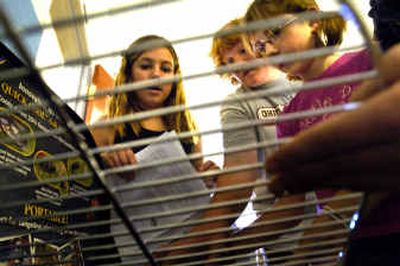Getting the funds

It’s time to batten down the bank account because fund-raiser season is knocking on the door. More than ever, John Q. Public is being asked to donate or make purchases that fund things that schools used to cover. In the next few weeks, students will sell everything from gift wrap to poinsettias in an effort to raise money to bolster sports and outside learning activities. Throw in candy and Entertainment Book sales and household checkbooks are in for a triathlon-style workout.
“It’s just a lot when you get the band raising money and you get the cheerleaders raising money and you get all the groups raising money and it seems like someone is at your doorstep a lot,” said Doug Matson, assistant superintendent for West Valley School District.
Fund-raisers subsidize every sport and activity done outside the classroom, Matson explained. In the past few years, school districts have dealt with challenges stemming from declining enrollment, which results in less money from the state. As districts watch their bank accounts shrink, costs of utilities, textbooks and other expenses are rising.
Associated student bodies organize fund-raising activities and distribute the money to help pay for each school’s clubs, sports and outside-learning activities.
Tim Ames, principal of Centennial Middle School said the extracurricular activities keep kids involved and looking forward to school – something that’s crucial at this tumultuous phase of their lives.
This year, the school’s fun run raised $16,000, which pays for planners for students to keep track of daily assignments, Math Counts, Destination Imagination, dances, convocations to educate kids about drug use and awards for honors students.
“These things are not funded by the state. We have to fund-raise to do these things,” Ames said.
“To me the whole benefit is kids get to experience a lot more.”
Ken VanSickle, vice principal and activities coordinator for University High School said clubs and sports teams keep kids on track and help build social, organizational and teamwork skills.
VanSickle said by the end of the year, groups will have held two or three dozen fund-raisers. One of the more creative U-Hi events includes a shut-up-a-thon for the talkative Debate Club members.
“People pay the debate kids to be quiet and they go around and get pledges not to talk,” VanSickle said.
Some school districts are dealing with unique challenges. West Valley is bearing the brunt of nearly $100,000 in costs for a program to transport students through areas that have hazards, such as railroad crossings.
Initially, the state paid the cost, but then it stopped funding the mandated program.
Matson doesn’t argue the program’s merit, but said funding it is tough. “All of a sudden we lost $100,000. We had to find the money somewhere,” Matson said.
East Valley School District once helped pay for band uniform expenses. But things changed after the bankrupt Kaiser Aluminum defaulted on its tax bill and the district watched its reserves dwindle.
Several years ago, the school purchased uniforms to be worn by more than 100 band members who were competing regularly and winning awards. The cash-strapped district didn’t contribute anything toward the $22,000 uniform bill.
The ASB, the school’s fund-raising umbrella, kicked in money. However, the Band Boosters, a group of band parents, bore the brunt of the expense and are trying to pay off the remainder of the $3,000 to $5,000 that’s owed.
“It’s been a real struggle to figure out how to finish paying for them,” said Karen Volland, president of Band Boosters.
Booster clubs organize to raise money for specific activities and sports. Those parents often find themselves working tirelessly to organize craft sales and other events.
“Getting parents that have the time, energy and inclination to help is hard,” Volland said.
The group is also raising money for traveling costs. Although marching band fees rose to $100 per musician – and the kids often sleep in gyms when they travel to competitions – costs for meals and charter buses add up.
As many parents discover, the senior year of high school is pricey. Seniors at Lewis and Clark High School recently held a T-shirt sale to raise money for their prom and breakfast.
The group has saved $1,500 so far. Students hope to raise an additional $4,000 to $6,000 through car washes, ornament sales and other events to pay for decorations, music, room rental, ticket printing and other expenses.
Jennifer Showalter, a teacher and senior class adviser, said without fund-raising, graduating students would celebrate their prom in the school gym and ticket prices would steeply climb.
“The ideas come from the kids and the participation comes from them,” Showalter said. “I’ve got students who are like miniature adults who take charge.”
Rather than holding a series of fund-raisers, Centennial Middle School pared down to a single fun run.
“This is a one-time deal. Let’s get it done quickly so we don’t have to keep asking our community for money,” Ames said.
Centennial students gather pledges and then dress in costumes that represent their grades.
The kids run and walk laps around the school, while rock music plays in the background. A big rally is held and prizes donated by area businesses are awarded to kids bringing in $15 or more.
Stacia Kline, an eighth-grade student, said some of the people she approached for donations didn’t understand that activities are paid for largely with fund-raising dollars.
Once she explained what the money goes toward, Kline said people were generally supportive.
“It helps pay for almost everything I do. We get to meet others” and “it helps us learn new things.”